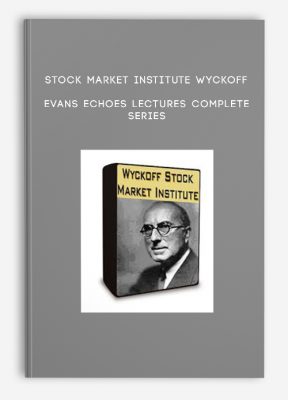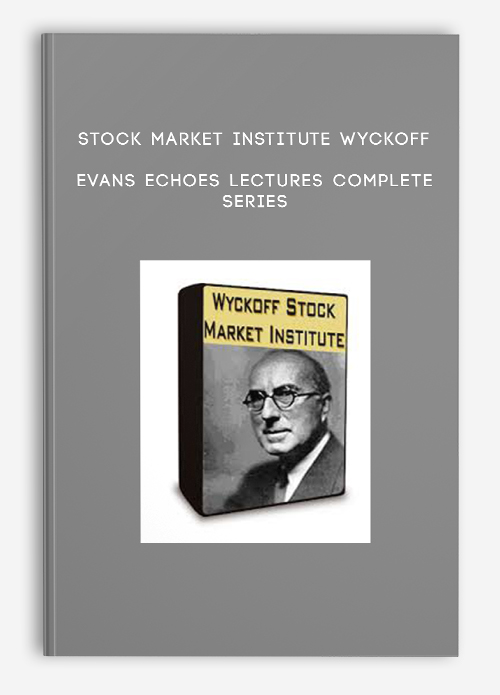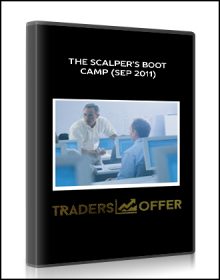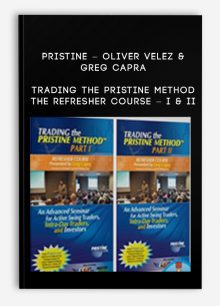Stock Market Institute Wyckoff Evans Echoes Lectures COMPLETE Series
$245.00 $109.00

Stock Market Institute Wyckoff Evans Echoes Lectures COMPLETE Series
Get Stock Market Institute Wyckoff Evans Echoes Lectures COMPLETE Series on Salaedu.com
Description:
Welcome to the SMI Evans Echoes Lectures. Over the years, the Stock Market Institute has focused its efforts on teaching the Wyckoff Method to over 5 generations of students. While many stock issues have appeared and disappeared (Mr. Wyckoff probably would have been shocked to learn that a stock could be named Google). the Wyckoff methods and principles have remained constant and made many Wyckoff traders very successful.
The lectures are a great opportunity to brush up on important Wyckoff principles. It’s the little things we tend to forget that seem to yield the nice profits.
The Evans Echoes lectures are available for download in MP3 format. With a few exceptions, the lectures are accompanied by the related charts, in an Adobe Acrobat format.
To insure quality, these lectures are large files. Depending on your Internet connection can can take several minutes to download the files to your computer. Please be patient.
Wyckoff is explained by the SMI’s great communicator, Robert Evans. Enjoy these wonderful and timeless stories and examples about how you can trade profitably using the Wyckoff methods. Each lecture, unless marked otherwise, includes accompanying charts.
Evans Echoes Lectures (roughly 100 lessons @$20 per lesson) $2,000.00 List Price
– A Change In Pace
– A Study Of Short Selling
– A Study Of The Optimism Pessimism Index
– Analysis of Optimism Pessimism
– Answering Basic Questions
– Anticipate What Will Happen After A Climax
– Anticipating The End Of A Decline
– Anticipation, The Road To Profits
– Basic Law Of Cause & Effect
– Buy_Ones_Moving
– Buying On Climaxes
– Confessions Of A Poor Student
– Distribution & Decline
– Dont_Fight_Current
– Effort_vs_ Results
– Excellent Examples Of Wyckoff Principles
– Good Sound Reasons
– Having Problems With Stop Orders
– How Stocks Move
– How The Principles Of Wyckoff Work
– How To Watch A Select Group Of Stocks
– Hunting For Bargains
– Ice_Story
– Importance Of Selling Short
– ImportantWords
– Interpreting The Intra-day
– Justified Sign Of Weakness
– Learning From Mistakes
– Look For Principles- Not For Bargains
– Market Phases
– Market Principles-The Count Guide
– One Eyed Joe
– Phases At The Bottom
– Potential_Trading_Opportunities
– Preparation & Decline
– Principles Of Volume Action
– Principles That Work
– Protecting Your Thinking Ahead
– Recognizing Developing Opportunities
– Reviewing Market Action
– Reviewing Price and Volume Principles
– Rotation
– Searching For Counts
– Stepping_Stone_Counts
– Stocks With Character
– Stop Purchasing In A Trading Range
– Strong Resistance To Pressure
– The End Of A Down Move
– The Frog Story
– The Importance Of Thrusts
– The OOPs Story
– The Shell Hunter’s Tragedy
– TheBridgeStory
– Think-Decide-Act
– Tomorrow’s Battles Are Won Today
– Trading A Higher Priced Stock
– Trading Ranges
– Trend Lines
– Trend Lines & Counts
– Trend Lines-2
– Understanding Selling Climaxes
– Upthrusts
– Vital Principals To Learn From – Part 1
– Vital Principals To Learn From – Part 2
– Volume Off The Bottom
– Waiting For Something To Happen
– What To Buy and When
– When A Spring Isn’t A Spring
– Where Do You Sell
– Working With Figure Charts
– Wyckoff-Wave-OP-Barometer
– You Have To Have A Cause
– The Shell Hunter’s Tragedy
– Wyckoff Wave – O.P. – Barometer
– Market Philosophy – Income Tax & FCI
– Market Philosophy
– Think, Decide, Act
– Anticipation, The Road To Profits
– The Law of Supply & Demand / Wyckoff Wave & O.P.
– Frog Story —————————–Classic (no charts)
– How Stocks Move
– Tomorrow’s Battles Are Won Today
– The One Eyed Joe —————–Classic
– The Oops Story ———————Classic
– The Ice Story ————————Classic
– Anticipating The End of a Decline
– Searching For Counts
– Don’t Fight The Current
– The Bridge Story – Points of Support
– Using Market Tools
– Important Words – Supply & Demand
– Good Sound Reasons or Reasons That Just Sound Good (no charts)
– You Have To Have A Cause
– Learning Lessons With Union Carbide
– Learning Lessons With Union Carbide – Part 2
– Thoughts On How To & Not To Trade
– Who’s Boss
– TWA – Timely Wyckoff Applications
– Market Phases
– Look For Principles, Not For Bargains
– What – How – Why (no charts)
– The End Of A Down Move
– Keeping Your House In Order
– The Importance Of Perspective
– When A Spring Isn’t A Spring
– Reviewing The Market
– A Case Study Of Fundamental Principles
– Hunting For Bargains
– A Lesson In Perspectives
– The Importance Of Being Alert
– A Study Of Strides
– Answering Basic Questions (no charts)
– Buying On Climaxes
– Stepping Stone Counts
– The Importance Of Thrusts
– Interpreting The Intra-day
– Principles Of Volume Action
– Understanding Selling Climaxes
– Buy The Ones That Are Moving
– Using All Your Crayons – A Detailed Stock Study
– Reviewing Price and Volume Principles
– Interpreting Market Action
– Analyzing Potential Trading Opportunities
– Trading A Higher Priced Stock
– Tips On What To Buy and When
– Market Philosophy (no charts)
– Learning From Mistakes
– When Something Is Nothing & Nothing Is Something
– Pay Attention To What Is Important / Disregard What Is Not
– Seeing Things As They Are
– A Change In Pace
– How To Study A Stock
– Distribution & Decline
– Learning Lessons Through Analysis
– The Market Is Made Of Maybes
– An Analysis Of The Optimism Pessimism
– What & Why
– Trading Range Analysis
– Being Right Is Not Enough
– A Long Term Study – Part 1
– A Long Term Study – Part 2
– A Long Term Study – Part 3
– A Long Term Study – Part 4
– A Long Term Study – Part 5
– A Study Of The Optimism Pessimism Index
– An Unfolding Picture – Part 1
– An Unfolding Picture Continues – Part 2
– An Unfolding Picture – Part 3
– The Unfolding Picture Continues – Part 4
– Potluck
– Working With Figure Charts
– Preparation & Decline
– Recognizing Developing Opportunities
– Trading Ranges
– Volume Off The Bottom
– Reviewing Market Action
– Market Philosophy
– The Wyckoff Wave – O.P. Relationship
– The Wyckoff Wave – O.P. Relationship (A Quiz)
– Phases At The Bottom
– Confessions Of A Poor Student
– Trend Lines
– Buy The Stocks That Are Moving
– Rotation
– A Study Of Short Selling
– Turning Point Indications
– Making Decisions
– Waiting For Something To Happen
– Study A Stock
– Analyzing The Wyckoff Wave
– How To Watch A Select Group Of Stocks
– What Is The Market Doing As A Whole
– Getting Acquainted With A Stock
– Stocks With Character
– Principles That Work
– Chart Study – Without Influence
– Having Problems With Stop Orders
– Recognizing A Climax
– Study The Wyckoff Wave
– Helpful Questions & Answers
– Similarity Between Expressways & The Market
– Where Do You Sell
– Understanding The Picture
– Market Philosophy
– Stop Purchasing In A Trading Range
– Taking A Chance
– Ironing Out Problems
– Buying The Stock That Is Moving
– Getting Acquainted With A Stock
– Stock Study
– What Exists After A Stock Split
– Stop Order Protection
– Reasons Why You Never Predict The Market
– Justified Sigh Of Weakness
– Vital Principals To Learn From – Part 1
– Vital Principals To Learn From – Part 2
– Excellent Examples Of Wyckoff Principles
– Comparing The Auto Stocks
– It Pays To Get Acquainted
– Learning Wyckoff Principles
– You Have Got To Train Yourself
– Trend Lines
– Strong Resistance To Pressure
– Effort vs. Results
– Wyckoff Wave & Stock Analysis
– Taking A Second Look
– The Perfect Trade
– Never Free From Risk
– Selling Short
– Hindsight Can Be Foresight
– Stock Study
– Know A Stock’s Character
– Trend Lines & Counts
– Visualize Trading Ranges – Not The Headlines
– Stocks That Move Consistently
– Upthrusts
– Wyckoff Wave & O.P. Index
– Importance Of Selling Short
– Basic Law Of Cause & Effect
– Market Principles ( The Count Guide )
– Protecting Your Thinking Ahead
– Anticipate What Will Happen After A Climax
– How The Principles Of Wyckoff Work
Forex Trading – Foreign Exchange Course
Want to learn about Forex?
Foreign exchange, or forex, is the conversion of one country’s currency into another.
In a free economy, a country’s currency is valued according to the laws of supply and demand.
In other words, a currency’s value can be pegged to another country’s currency, such as the U.S. dollar, or even to a basket of currencies.
A country’s currency value may also be set by the country’s government.
However, most countries float their currencies freely against those of other countries, which keeps them in constant fluctuation.
More Course: FOREX TRADING
Outstanding Course:Tim Lowe – Football Hedging System
1 review for Stock Market Institute Wyckoff Evans Echoes Lectures COMPLETE Series
Add a review Cancel reply
Related products
Forex - Trading & Investment
Forex - Trading & Investment
Michael Parsons – Channel Surfing Video Course (Manual,Video)
Forex - Trading & Investment
Forex - Trading & Investment
Forex - Trading & Investment
Pristine – Oliver Velez & Greg Capra – Trading the Pristine Method. The Refresher Course – I & II
Forex - Trading & Investment
Pristine – Oliver Velez – Core, Swing, Guerrilla, Momentum Trading, Micro Trading Tactics










king –
We encourage you to check Content Proof carefully before paying.
“Excepted” these contents: “Online coaching, Software, Facebook group, Skype and Email support from Author.”
If you have enough money and feel good. We encourage you to buy this product from the original Author to get full other “Excepted” contents from them.
Thank you!